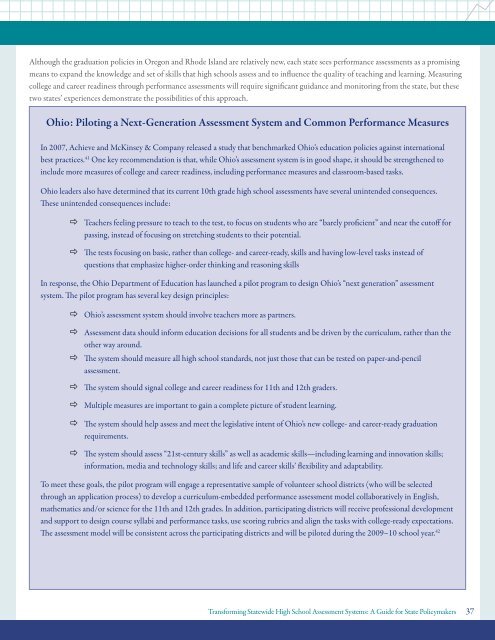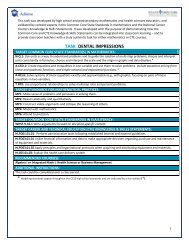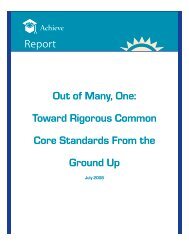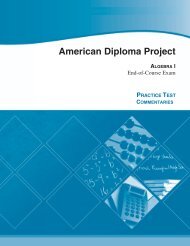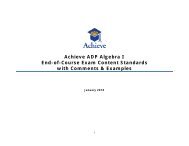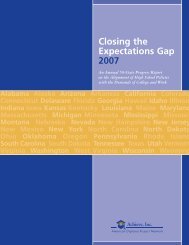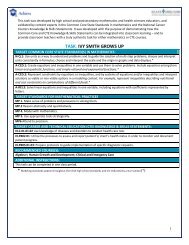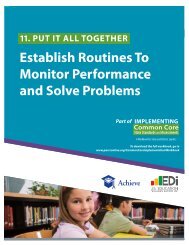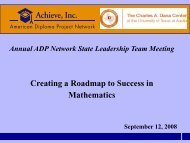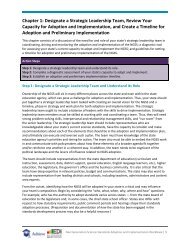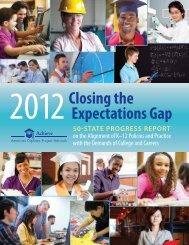graduation. Hawaii, Louisiana and Texas require graduation projects for students earning an honors or advanced diploma. In Kentucky,students earning a technical/vocational diploma must complete a culminating project related to their career cluster or major. 37 In all thesecases, it is the local high school that administers the assessment, gauges student performance and decides if it is “good enough” to meetgraduation requirements.States also are stimulating, requiring and/or scoring performance assessments statewide. States are developing formal or informalpartnerships with districts and nonprofits in order to encourage performance assessment linked with state standards.Kentucky has the longest-running statewide performance assessment of any state. <strong>High</strong> schoolers must complete writing portfolios,which are included in the statewide school accountability index. 38 The writing portfolios are scored locally, while the state department ofeducation plays a central role in auditing and providing extensive scoring training and professional development.The New Jersey Performance <strong>Assessment</strong> Alliance (NJPAA) is a five-year grant-funded project designed to develop, administer, andscore valid and reliable performance prompts that will complement statewide standardized tests. The prompts measure mastery of statestandards that are not currently assessed by summative tests through multiple-choice or constructed-response items. All prompts requirestudents to apply their skills and knowledge in a novel way. Participants in NJPAA have administered tasks in language arts literacy,mathematics and science at grades 3, 6, 8 and 11. More than 100 school districts, including hundreds of teachers and thousands ofstudents representing a cross-section of New Jersey, have participated to date.Of particular note is the use of a performance task along with the state’s new EOC test in Biology/Life Science. The EOC test is mostlymultiple-choice, with some constructed-response items, and was operational for the first time in spring 2008. The New Jersey Departmentof Education (NJDOE) and NJPAA field-tested a performance assessment prompt of approximately 90 minutes with all students who tookthe Biology EOC test in 2008. Student responses to this prompt are scored and reported by NJPAA to the NJDOE. The state has madeprompts, student response booklets and full sets of teacher guidelines indicating how the prompts align to standards available online. 39 Atthis time, though student scores on the prompt will not form part of the student score for the Biology/Life Science EOC test, by couplingthe EOC test with the performance task, the state is signaling that both kinds of assessment are needed to measure student achievement.Other states—most notably Oregon, Washington and Wyoming 40 —include a process referred to as “collections of evidence” in theirassessment systems. Since 2000, Oregon has employed a “collections of evidence” approach to supplement the state’s multiple-choicesummative tests with performance tasks. Students submit to the state a series of work samples in reading, writing and mathematics thatrepresent their growth to standards and quality of work over time. This collection supplements the state’s multiple-choice standardizedtest. The work samples can include research papers, experiments, speaking presentations and work experience. To support local schoolsystems, the Oregon Department of Education (ODE) provides educators with sample tasks, prompts and examples of score student work;the mandatory official scoring guide also gives schools specific, consistent criteria for assessing students’ performance, along with gradelevelanchors and scoring rubrics. To promote both transparency and consistency, the ODE also has created a practice scoring Web site toprovide teachers, students and parents an opportunity to practice scoring student papers and receive feedback on their scoring accuracy.Rhode Island has designed its new high school graduation requirements to rest upon a comprehensive system of locally designedperformance assessments. Beginning with the graduating class of 2008, high school students must demonstrate proficiency in appliedlearning skills in ELA, mathematics, science, social studies, technology and the arts. It is up to schools to decide whether students areassessed through portfolios, exhibitions, EOC assessments or Certificates of Initial Mastery. Rhode Island has developed an online toolkit to provide schools with detailed assistance in the planning, development and implementation of a local assessment system that isaligned to the state’s grade-level standards and allows students to cultivate personal interest and deeper knowledge in the content areas.Although schools have latitude to develop performance assessments that best fit their communities, the state monitors their rigor, validity,reliability and alignment with standards through a “peer support and review” process.<strong>Transforming</strong> <strong>Statewide</strong> <strong>High</strong> <strong>School</strong> <strong>Assessment</strong> <strong>Systems</strong>: A Guide for State Policymakers 36
Although the graduation policies in Oregon and Rhode Island are relatively new, each state sees performance assessments as a promisingmeans to expand the knowledge and set of skills that high schools assess and to influence the quality of teaching and learning. Measuringcollege and career readiness through performance assessments will require significant guidance and monitoring from the state, but thesetwo states’ experiences demonstrate the possibilities of this approach.Ohio: Piloting a Next-Generation <strong>Assessment</strong> System and Common Performance MeasuresIn 2007, <strong>Achieve</strong> and McKinsey & Company released a study that benchmarked Ohio’s education policies against internationalbest practices. 41 One key recommendation is that, while Ohio’s assessment system is in good shape, it should be strengthened toinclude more measures of college and career readiness, including performance measures and classroom-based tasks.Ohio leaders also have determined that its current 10th grade high school assessments have several unintended consequences.These unintended consequences include:Teachers feeling pressure to teach to the test, to focus on students who are “barely proficient” and near the cutoff forpassing, instead of focusing on stretching students to their potential.The tests focusing on basic, rather than college- and career-ready, skills and having low-level tasks instead ofquestions that emphasize higher-order thinking and reasoning skillsIn response, the Ohio Department of Education has launched a pilot program to design Ohio’s “next generation” assessmentsystem. The pilot program has several key design principles:Ohio’s assessment system should involve teachers more as partners.<strong>Assessment</strong> data should inform education decisions for all students and be driven by the curriculum, rather than theother way around.The system should measure all high school standards, not just those that can be tested on paper-and-pencilassessment.The system should signal college and career readiness for 11th and 12th graders.Multiple measures are important to gain a complete picture of student learning.The system should help assess and meet the legislative intent of Ohio’s new college- and career-ready graduationrequirements.The system should assess “21st-century skills” as well as academic skills—including learning and innovation skills;information, media and technology skills; and life and career skills’ flexibility and adaptability.To meet these goals, the pilot program will engage a representative sample of volunteer school districts (who will be selectedthrough an application process) to develop a curriculum-embedded performance assessment model collaboratively in English,mathematics and/or science for the 11th and 12th grades. In addition, participating districts will receive professional developmentand support to design course syllabi and performance tasks, use scoring rubrics and align the tasks with college-ready expectations.The assessment model will be consistent across the participating districts and will be piloted during the 2009–10 school year. 42<strong>Transforming</strong> <strong>Statewide</strong> <strong>High</strong> <strong>School</strong> <strong>Assessment</strong> <strong>Systems</strong>: A Guide for State Policymakers 37


